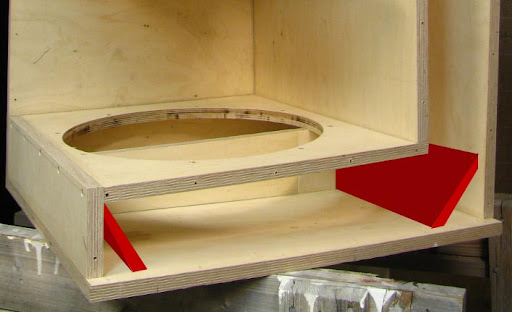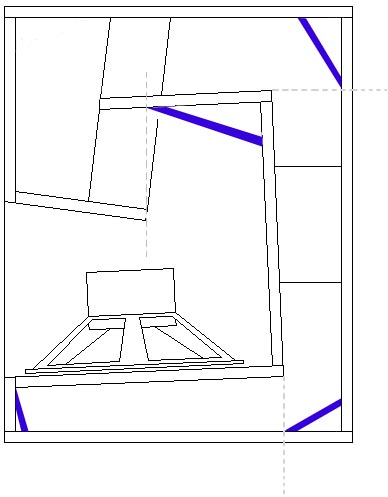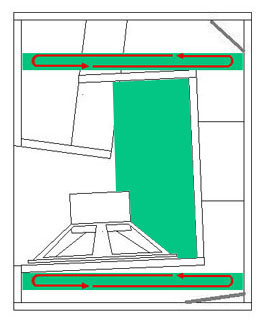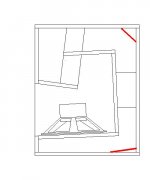Thanks, positive feedback (or the oposite) from the brilliant minds here mean alot to me, you know the issues involved, you know what to expect, critics without knowhow does not bother me, but when you guys post a sugestion it goes straight to the drawingboard.
So there is now a MKIII and even a MKIV in the works outside dims and folding geometry are the same, it's just a matter of reflector positions, so there's nothing fancy going on there, but it will show the importance of .
outside dims and folding geometry are the same, it's just a matter of reflector positions, so there's nothing fancy going on there, but it will show the importance of .
The MKIII and MKIV are post build modifications, adding reflectors in the bottom path via the cutout, it is a four pice kit due to the bottom brace, where the MKIII is for the MKII post build, and the MKIV is for the original post build, are you with me on this ? (not very clear i know, I'll try to explain).
Jbell's sugestion very early on when William's proposal to use refelctors came up, was to add refelctors in the bottom path only, and William's sugestion was to use them in the upper path, both valid and very intresting ideas to be taken most seriously under consideration.
So, William's proposal is the base for the MKII, which is shown above, and JBell's is the base for the MKIV whick I will give a go in the near future since I use the original, the MKIII is a hybrid adding reflectors along the entire path of the horn.
The MKIII mod was sugested by Djim69 from the netherlands over at speakerplans.com, and he even posted a very nice picture to describe it :

SlaitH, who built the MKII's shown above, later figured out that the MKIII modification perhaps could be fitted post build.
All of this, phew..., can now be arraganged as follows :
Original THAM15
Original THAM15 with relfectors in the upper path - MKII
Original THAM15 with relfectors in the upper and lower paths - MKIII (post build mod. of MKII)
Original THAM15 with relfectors in the lower path only - MKIV (post build mod. of the original)
The MKII and/or MKIII can be identified by the appature chamfer, this is not present on the original and the MKIV.
The only way to know for sure is to remove the driver and look inside, or (perhaps easier) ask the guy who built them
So there is now a MKIII and even a MKIV in the works
The MKIII and MKIV are post build modifications, adding reflectors in the bottom path via the cutout, it is a four pice kit due to the bottom brace, where the MKIII is for the MKII post build, and the MKIV is for the original post build, are you with me on this ? (not very clear i know, I'll try to explain).
Jbell's sugestion very early on when William's proposal to use refelctors came up, was to add refelctors in the bottom path only, and William's sugestion was to use them in the upper path, both valid and very intresting ideas to be taken most seriously under consideration.
So, William's proposal is the base for the MKII, which is shown above, and JBell's is the base for the MKIV whick I will give a go in the near future since I use the original, the MKIII is a hybrid adding reflectors along the entire path of the horn.
The MKIII mod was sugested by Djim69 from the netherlands over at speakerplans.com, and he even posted a very nice picture to describe it :

SlaitH, who built the MKII's shown above, later figured out that the MKIII modification perhaps could be fitted post build.
All of this, phew..., can now be arraganged as follows :
Original THAM15
Original THAM15 with relfectors in the upper path - MKII
Original THAM15 with relfectors in the upper and lower paths - MKIII (post build mod. of MKII)
Original THAM15 with relfectors in the lower path only - MKIV (post build mod. of the original)
The MKII and/or MKIII can be identified by the appature chamfer, this is not present on the original and the MKIV.
The only way to know for sure is to remove the driver and look inside, or (perhaps easier) ask the guy who built them
epa:
I can confirm in my dozens of TH cabinets, that adding reflectors is always a net minus. That doesn't mean that they aren't helpful. Usually they shave off the peaks and fill in the valley's so to speak, but at an overall loss of 'area under the curve' because the shaving of the peaks is more net minus than the filling in of the valleys is a net plus.
My best analogy is that segments of a folded TH are like piano strings... too many that are similar equal a note that sticks out too loud. If they are all different, then it's like playing a rich chord on a piano. A reflector changes the resonance of that segment of the horn, and a shallow reflector affects it completely different than a 45degree reflector. Some resonances are beneficial. (This is all just my opinion... who knows, I may be crazy....)
My suggestion for the fewest reflectors that will have the maximum positive impact on the martisson cabinet is shown in red.
I can confirm in my dozens of TH cabinets, that adding reflectors is always a net minus. That doesn't mean that they aren't helpful. Usually they shave off the peaks and fill in the valley's so to speak, but at an overall loss of 'area under the curve' because the shaving of the peaks is more net minus than the filling in of the valleys is a net plus.
My best analogy is that segments of a folded TH are like piano strings... too many that are similar equal a note that sticks out too loud. If they are all different, then it's like playing a rich chord on a piano. A reflector changes the resonance of that segment of the horn, and a shallow reflector affects it completely different than a 45degree reflector. Some resonances are beneficial. (This is all just my opinion... who knows, I may be crazy....)
My suggestion for the fewest reflectors that will have the maximum positive impact on the martisson cabinet is shown in red.
Attachments
Last edited:
Martinsonn;
In my reflector suggestion (you named it: THAM MKIII) it was not just the reflectors in the first selection but together with… Anyways, I include a picture of my suggestion.

My reflectors are based on one of the oldest theories in acoustics that no wall should have a parallel image. That’s why my reflectors always will ‘see’ (at least) one edge of the corner (grey line to make this visible). Also, I never try to make them perfect 45 degrees but more or less 30-40 degrees. This is also based on AES guidelines/papers.
I also agree with Jbell that the less reflectors the better since they will introduce new side effects in other areas. But if you want to use the Tham up to 250/300Hz you have to deal with the dip around 170/180Hz.
In my reflector suggestion (you named it: THAM MKIII) it was not just the reflectors in the first selection but together with… Anyways, I include a picture of my suggestion.

My reflectors are based on one of the oldest theories in acoustics that no wall should have a parallel image. That’s why my reflectors always will ‘see’ (at least) one edge of the corner (grey line to make this visible). Also, I never try to make them perfect 45 degrees but more or less 30-40 degrees. This is also based on AES guidelines/papers.
I also agree with Jbell that the less reflectors the better since they will introduce new side effects in other areas. But if you want to use the Tham up to 250/300Hz you have to deal with the dip around 170/180Hz.
Last edited:
Sorry for the bad drawing (especialy last reflector section which comes way to much in the path) since I have no skills/software in this area... Just make every reflector about 15 - 20 degrees and start from the grey line. when two reflectors 'see' each other it always will be in a 30-40 degree angle or 60 - 80 degree angle...
Last edited:
intresting,so avoiding simular lengts first,and then if nessecary correct with non 45 degrees deflectors.epa:
I can confirm in my dozens of TH cabinets, that adding reflectors is always a net minus. That doesn't mean that they aren't helpful. Usually they shave off the peaks and fill in the valley's so to speak, but at an overall loss of 'area under the curve' because the shaving of the peaks is more net minus than the filling in of the valleys is a net plus.
My best analogy is that segments of a folded TH are like piano strings... too many that are similar equal a note that sticks out too loud. If they are all different, then it's like playing a rich chord on a piano. A reflector changes the resonance of that segment of the horn, and a shallow reflector affects it completely different than a 45degree reflector. Some resonances are beneficial. (This is all just my opinion... who knows, I may be crazy....)
My suggestion for the fewest reflectors that will have the maximum positive impact on the martisson cabinet is shown in red.
i gues the best way to go is bilding a test box with a removable side.
could one make them of some sort of stiff foam?
intresting,so avoiding simular lengts first,and then if nessecary correct with non 45 degrees deflectors.
i gues the best way to go is bilding a test box with a removable side.
could one make them of some sort of stiff foam?
For a useful exercise, try working out what resonances might be set up with the parallel walls and the like in the tapped-horn, or at what frequencies those reflectors are actually going to be useful, then determining whether or not those frequences are actually going to be in or even near the tapped-horn's passband. I'll bet that you'll find that those frequencies are outside, perhaps even way outside, the tapped-horn's passband.
IMO good bracing is going to be a lot more useful in the tapped-horn than inserting reflectors or ensuring that no walls are parallel. With that in mind, don't skimp on bracing in the 1st or 3rd sections of the tapped-horn. If you do, the end result will be panel flex and increased distortion at the upper end of the tapped-horn's passband (my experience).
agreed with the "flappy"ends needs bracing(got them on my flh's, althoug it keeps them clear of beerglassesFor a useful exercise, try working out what resonances might be set up with the parallel walls and the like in the tapped-horn, or at what frequencies those reflectors are actually going to be useful, then determining whether or not those frequences are actually going to be in or even near the tapped-horn's passband. I'll bet that you'll find that those frequencies are outside, perhaps even way outside, the tapped-horn's passband.
IMO good bracing is going to be a lot more useful in the tapped-horn than inserting reflectors or ensuring that no walls are parallel. With that in mind, don't skimp on bracing in the 1st or 3rd sections of the tapped-horn. If you do, the end result will be panel flex and increased distortion at the upper end of the tapped-horn's passband (my experience).
maybe upper harmonics wil come in to play?so testing is the way to go.
intresting,so avoiding simular lengts first,and then if nessecary correct with non 45 degrees deflectors.
i gues the best way to go is bilding a test box with a removable side.
could one make them of some sort of stiff foam?
exactly. Glue with PL everything except for the second side. Lay the 2nd side on and draw as many lines as you can so you can exactly locate where all of the interior panels intersect with the 2nd side. Screw down through all of the interior and exterior panels, at least 2 screws per panel. You can then take 3/8" door/window gasket foam and line all of the panels that intersect the 2nd side.
Install the reflectors you want to test with screws, and then screw down the 2nd side. When you are done testing, you can remove the side and change your reflectors. Go ahead and make the reflectors out of wood, no need to foam.
repeat
repeat
repeat
For a useful exercise, try working out what resonances might be set up with the parallel walls and the like in the tapped-horn, or at what frequencies those reflectors are actually going to be useful, then determining whether or not those frequences are actually going to be in or even near the tapped-horn's passband. I'll bet that you'll find that those frequencies are outside, perhaps even way outside, the tapped-horn's passband.
IMO good bracing is going to be a lot more useful in the tapped-horn than inserting reflectors or ensuring that no walls are parallel. With that in mind, don't skimp on bracing in the 1st or 3rd sections of the tapped-horn. If you do, the end result will be panel flex and increased distortion at the upper end of the tapped-horn's passband (my experience).
well, I can say a single 12degree reflector COMPLETELY changed the behavior on my 2x2x4 TH. I had a stuffy 70hz that was 8db down. That ONE reflector reduced my severe 50hz bump by 2db, and increased my 70hz by 4db.
The only way you find these kind of things is to build it and measure.
Last edited:
agreed with the "flappy"ends needs bracing(got them on my flh's, althoug it keeps them clear of beerglasses)
maybe upper harmonics wil come in to play?so testing is the way to go.
I've got TWO layers of 3/4 ply AND a center brace on the first section of my test TH, and it STILL vibrates too much for my liking, and the panel flex introduces measurable distortion too. I'm thinking of trifurcating the complete length of the horn for the next build with braces - let's see if there will be noticeable panel flex after that
well, I can say a single 12degree reflector COMPLETELY changed the behavior on my 2x2x4 TH. I had a stuffy 70hz that was 8db down. That ONE reflector reduced my severe 50hz bump by 2db, and increased my 70hz by 4db.
That could be due to the increased bracing the reflector provided rather than anything else, but the only way to really tell would be to look at the impedance response before and after the addition. Panel flex seems to show up as unexpected blips in the impedance curve.
That could be due to the increased bracing the reflector provided rather than anything else, but the only way to really tell would be to look at the impedance response before and after the addition. Panel flex seems to show up as unexpected blips in the impedance curve.
uhhh... no.
A single 5" long reflector.... and this was 9 ply 3/4".... The reflector had NO effect on bracing, or reducing cabinet flex. All it did, was prevent a null where 2 waves of opposite phase were interacting with each other.
uhhh... no.
A single 5" long reflector.... and this was 9 ply 3/4".... The reflector had NO effect on bracing, or reducing cabinet flex. All it did, was prevent a null where 2 waves of opposite phase were interacting with each other.
A 70 Hz wave is about 16.1 ft. long
A 50 Hz wave is about 22.6 ft. long
I'm not sure how a 5" reflector can prevent a frequency null when we're talking about wavelengths that long, but as always I'm open to correction - horns design is fairly new to me.
Was this reflector in the first section of the horn? Did you include in your model the change in the horn's response that may be caused by reducing the cross-section at that point with the addition of the reflector?
Brain, its all about a quater of wavelength not full wavelengths...
Jbell, but why did you leave in your suggestion for the Tham still so much space open for the standing waves of about 50cm (170/180Hz)??? See green area in the picture with Jbells suggestion for reflectors…

Jbell, but why did you leave in your suggestion for the Tham still so much space open for the standing waves of about 50cm (170/180Hz)??? See green area in the picture with Jbells suggestion for reflectors…

djim:
ok, so you got me on the 45 degree reflector, it should be a bit bigger... I was giving an off the cuff answer.
In terms of the lower section, I don't know why, but the shallow reflector works there.
In the last vertical section, I never tried to fix that. My 2x2x4 cabinet has a HUGE hole, just like martisson has, and I gave up trying to fix it. Since I crossed it low, I ignored it.
My ss15 only has a 2hz wide notch in the 170hz range, so narrow that you'll never know... that's how I really fixed it.
ok, so you got me on the 45 degree reflector, it should be a bit bigger... I was giving an off the cuff answer.
In terms of the lower section, I don't know why, but the shallow reflector works there.
In the last vertical section, I never tried to fix that. My 2x2x4 cabinet has a HUGE hole, just like martisson has, and I gave up trying to fix it. Since I crossed it low, I ignored it.
My ss15 only has a 2hz wide notch in the 170hz range, so narrow that you'll never know... that's how I really fixed it.
Last edited:
Sorry Jbell, it was not meant to ‘get’ you but I was curious if the lower section would give enough reflection to kill the problem this design seems to have. Btw Shallow reflectors seem to work better simple because they are not as obstructive and still are steep enough to do the job. In my opinion 45 degree reflectors seem to bounce the original signal backwards (partly)…
Last edited:
Sorry Jbell, it was not meant to ‘get’ you but I was curious if the lower section would give enough reflection to kill the problem this design seems to have. Btw Shallow reflectors seem to work better simple because they are not as obstructive and still are steep enough to do the job. In my opinion 45 degree reflectors seem to bounce the original signal backwards…
or... 45's make 2 adjoining segments work kinda as a single larger segment -- I never know which it's going to do. I do know that multiple 45's and multiple paths don't work this way, but a single has somewhat of a different effect. (sorry, trying to give a generalization on something that you can't give a generalization on.)
There's a place for 45's... but it should be a 'careful' placing of 45's in my opinion.
Also, Tom has commented that sharp bends should be closer to the throat, not the mouth... that's also why I have my 180 bends up front, and my 90's at the end. The martisson style cabinet as well as my 2x2x4 cabinet are the opposite with the 180's at the end.
regardless... I know I've mentioned before... TH's are like a soup, and it's all in the seasoning at the end...
- Home
- Loudspeakers
- Subwoofers
- THAM15 - a compact 15" tapped horn

